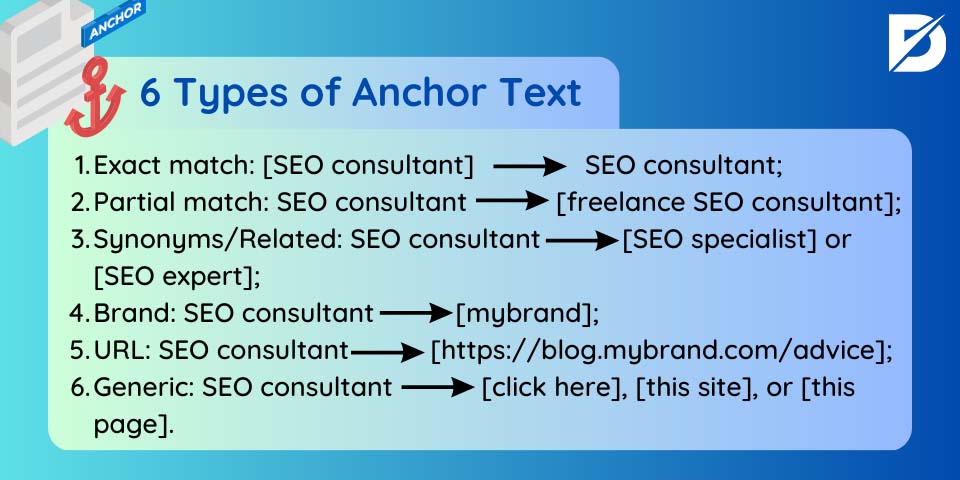The term anchor text refers to a portion of page text linked to another resource. To simplify it, they are words in the famous blue underlined links. These are present on all web pages, and whose click will redirect you to another page. Both within the same site where you publish the HTML anchor and outside.
But why did we decide to talk about it? What importance can the anchor link play on your site? Why should you focus particular effort on correctly interpreting the meaning of anchoring?
Let’s go in order!
What is Anchor Text?
Anchor text is the HTML code for the link texts you make to the content on your website. Anchor text is divided into two; internal links and external links. When you give a link from the keyword “What is SEO“, it will look like this in HTML;
<a href=”https://www.dopinger.com/blog/what-is-seo”>What is SEO?</a>

The links and keywords must be relevant because search engine bots use anchor text to understand the context of website pages. Let’s say you build a link to your page with SEO keywords with pages about SEO. The search engine bots will understand that your page is about SEO.
The Importance of Anchor Text
Search engine bots consider the anchor text of links knowing that they are human-generated and that the text in the target in the target site and the anchor text is relevant to the site being submitted. Thus, it becomes easier for your page to rank according to the searches made. Backlinks and internal links with different anchor text containing your main keyword affect your ranking on search engines.
HTML Anchor: Google’s Rules for Having the Best
The SEO experts understood very quickly that using a certain type of anchor text could lead to interesting positioning results on search engines. However, starting from this idea, they began to “abuse” it to the point that Google introduced various algorithms – such as Penguin – which penalized the excessive use of anchor texts containing the same “dry key”. Let’s see what tips Google’s Guide offers on how to improve HTML anchor text:
Choose Descriptive Texts
Make sure that the anchor text gives a basic idea of the content of the linked page, and instead avoid using generic anchors (such as “click here”), and in general words without relation to the content or URL;
Create Concise Text
Use short but descriptive text, and avoid very long sentences instead. So try to keep the length of the link as low as possible;
Format the Links So That They Are Easy to Find
Make sure that the links are easily distinguishable from the text, and instead, avoid they can be clicked by mistake -or worse- not found because perhaps the same color of the text. The basic settings of the editor you write online probably give you a helping hand, but this does not mean you cannot change them anyway. Keep in mind that by now, users have become accustomed to intercepting links, within a text, as in words underlined in blue;
Use Anchor Text for Internal Links
Pay close attention not only to external links but also to internal links on your site, making sure that they are useful and navigable for both Google and users. Therefore, try to take care of cross-linking in the best possible way to extend the reader’s stay on your site, sharing information that they may find increasingly useful.
We invite you to reflect on the fact that the guide clearly states that “a good anchor text will help Google understand what the page you are linking is about”. So take a cue from this important statement. And also “talking” anchor texts to help the user understand where it will end!
At the same time, as we have already partially mentioned, it is also important not to exceed the use of the same keywords on a too-high percentage of links.
6 Tips for Not Making Mistakes
In this scenario, it is good to remember that a “penalty-proof” strategy is used. More or less with the same percentages, these six types of anchor text:

- Exact match: I want to position myself for [SEO consultant], and therefore I use the same keyword as anchor text, e.g., SEO consultant;
- Partial match: in addition to the keyword of my interest, I insert some other related term in the anchor text, for example [freelance SEO consultant];
- Synonyms/Related: use as anchored text [SEO specialist] or [SEO expert];
- Brand: if I am already known, I could also use my brand, that is [mybrand];
- URL: I use the URL of the page I want to place, for example [https://blog.mybrand.com/advice];
- Generic: it is normal that some links must also come from totally generic terms, such as [click here], [this site], or [this page].
Finally, I remind you that anchor text is a very close relative of links. Google wants your links to be natural and NOT artificial.
Google is evolving, but can the same be said of the Link building market? Link building is often seen as the cure for all ills. Well, you won't b...
For Wix, SEO means the set of activities and techniques to improve the ranking on search engines and increase the organic traffic that makes use of th...
Therefore, Google will consider as artificial an excess of anchor texts with the same keyword inside, especially if this keyword is unnatural and people use it excessively compared to the other links you receive.
If you do link building/link earning, then gladly accept links with keywords that are not exactly “precise”, and do not insist on always and only wanting links with keywords that stink of SEO from miles away.
Conclusion on Anchor Text
We hope that these brief considerations on the more agreeable use of the HTML anchor can improve its use within your site. Remember that its conscious use can be very important to give your content an edge. However, like any element that can impact positioning – an error in its management, especially if protracted over time, could cost you dearly in terms of visibility.



No comments to show.